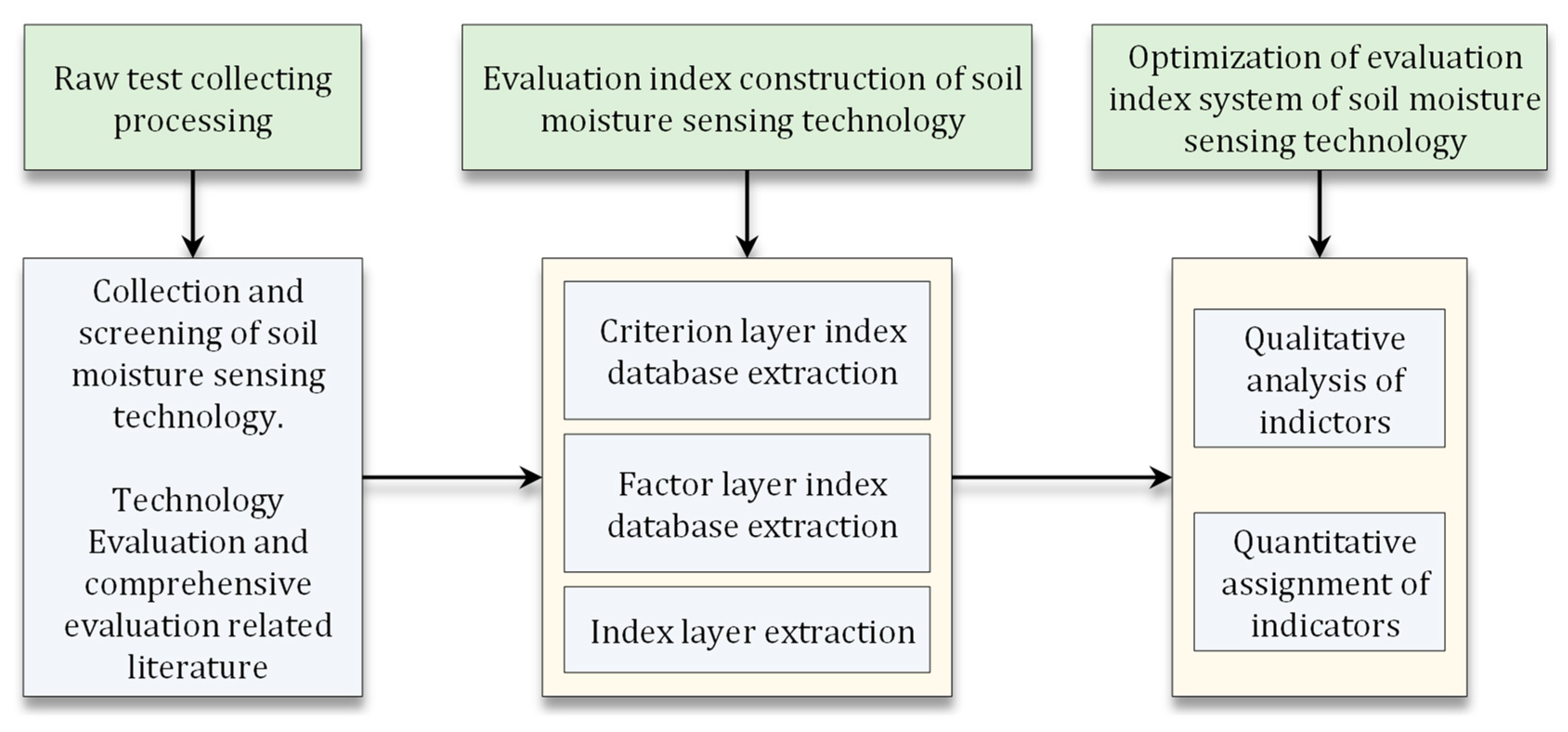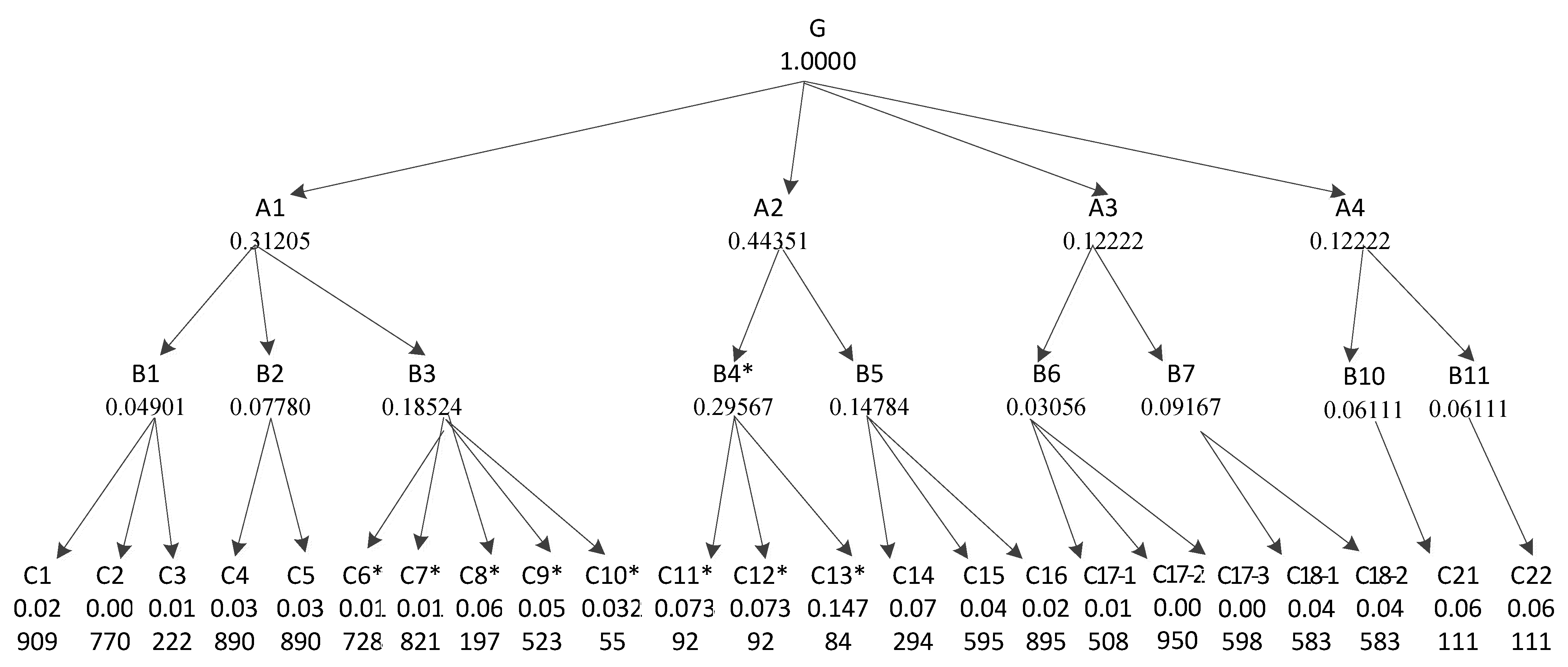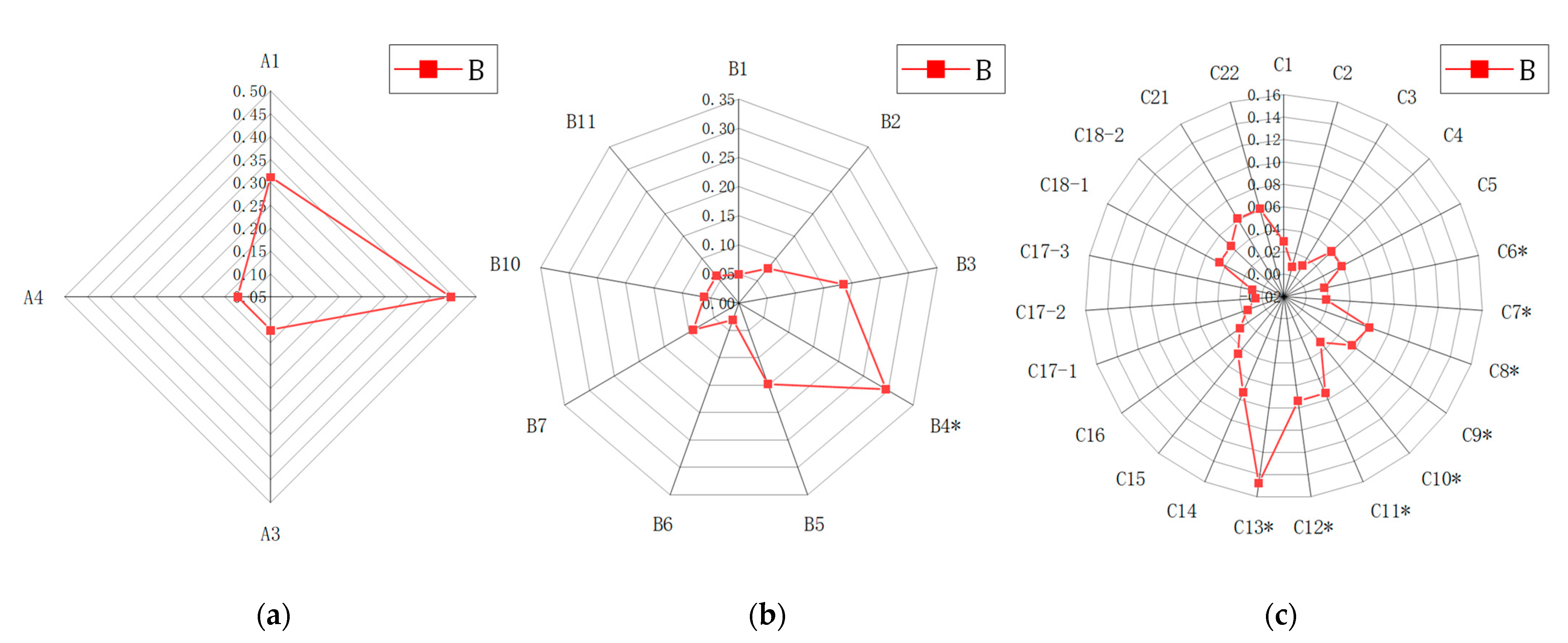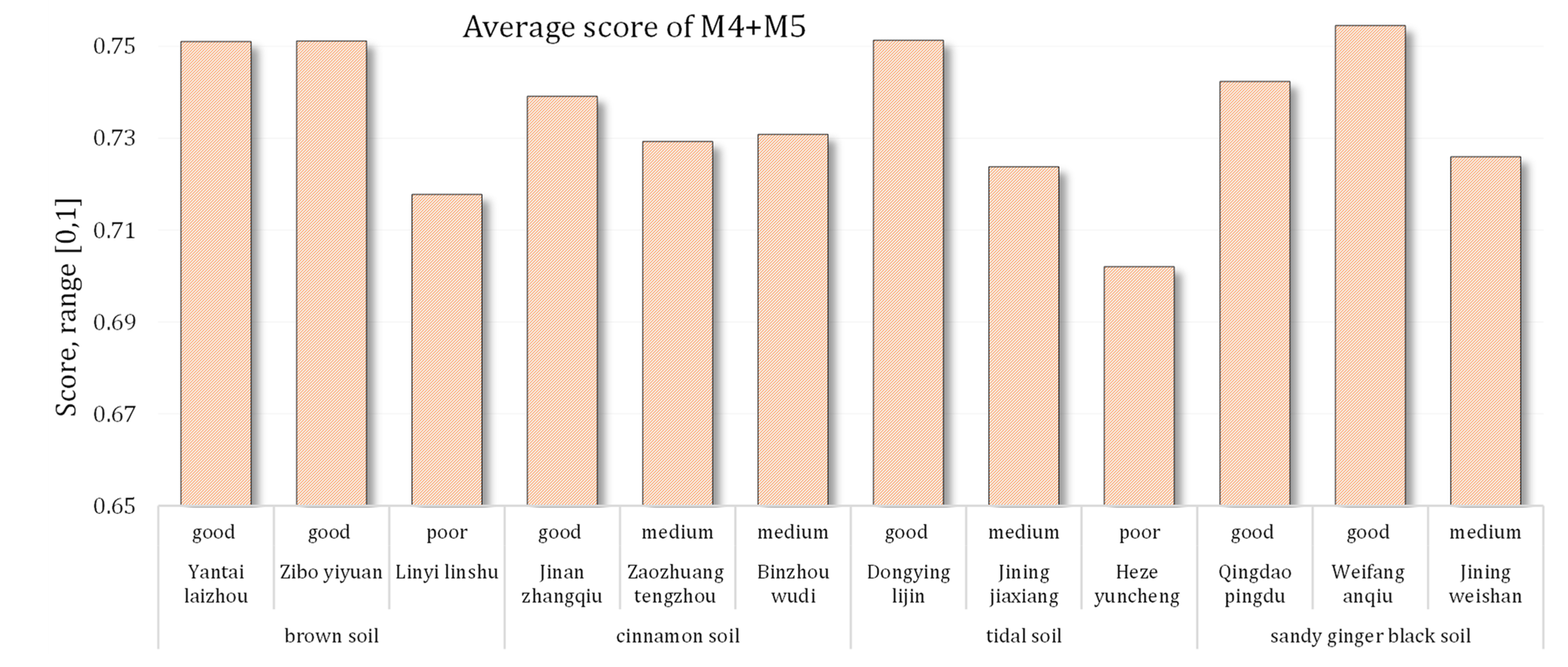Comprehensive Evaluation of Soil Moisture Sensing Technology Applications Based on Analytic Hierarchy Process and Delphi
Abstract
:1. Introduction
2. Materials and Methods
2.1. Overview of Soil Moisture Sensor Technology
2.2. Construction of Evaluation Index System
2.2.1. Construction Principles of Evaluation Index System
2.2.2. Influencing Factors of Comprehensive Evaluation
2.2.3. Construction Method of Evaluation Index System
2.3. Weight Calculation Method of Index System
2.4. Grade of Comprehensive Evaluation Results
2.5. Empirical Program Design
3. Results and Discussion
3.1. Determination of Evaluation Index System
3.2. Weight Results of Comprehensive Evaluation
3.3. Comprehensive Evaluation Influence Weight Analysis
3.4. Empirical Research
3.4.1. Comprehensive Results in One Farm
3.4.2. Comprehensive Results in All Farms
4. Conclusions
Author Contributions
Funding
Institutional Review Board Statement
Informed Consent Statement
Data Availability Statement
Conflicts of Interest
References
- Jackson, T.J. Measuring surface soil moisture using passive microwave remote sensing. Hydrol. Process. 1993, 7, 139–152. [Google Scholar] [CrossRef]
- Chow, L.; Xing, Z.; Rees, H.W.; Meng, F.R.; Monteith, J.; Stevens, L. Field performance of nine soil water content sensors on a sandy loam soil in New Brunswick, Maritime Region, Canada. Sensors 2009, 9, 9398–9413. [Google Scholar] [CrossRef] [PubMed]
- Gardner, W.; Kirkham, D. Determination of soil moisture by neutron scattering. Soil Sci. 1952, 73, 391–402. [Google Scholar] [CrossRef]
- Bogena, H.R.; Huisman, J.A.; Güntner, A.; Hübner, C.; Kusche, J.; Jonard, F.; Vey, S.; Vereecken, H. Emerging methods for noninvasive sensing of soil moisture dynamics from field to catchment scale: A review. Wiley Interdiscip. Rev. Water 2015, 2, 635–647. [Google Scholar] [CrossRef] [Green Version]
- Yu, L.; Gao, W.; Shamshiri, R.R.; Tao, S.; Ren, Y.; Zhang, Y.; Su, G. Review of research progress on soil moisture sensor technology. Int. J. Agric. Biol. Eng. 2021, 14, 32–42. [Google Scholar]
- Yin, Z.; Lei, T.W.; Yan, Q.H.; Chen, Z.P.; Dong, Y.Q. A near-infrared reflectance sensor for soil surface moisture measurement. Comput. Electron. Agric. 2003, 99, 101–107. [Google Scholar] [CrossRef]
- Hassan-Esfahani, L.; Torres-Rua, A.; Jensen, A. Assessment of surface soil moisture using high-resolution multi-spectral imagery and artificial neural networks. Remote Sens. 2015, 7, 2627–2646. [Google Scholar] [CrossRef] [Green Version]
- Shamshiri, R.R.; Weltzien, C. Development and field evaluation of a multichannel LoRa sensor for IoT monitoring in berry orchards. 41. GIL-Jahrestagung. In Informations- und Kommunikationstechnologien in Kritischen Zeiten; Gesellschaft für Informatik: Bonn, Germany, 2021; pp. 289–294. [Google Scholar]
- Sui, R.; Pringle, H.C.; Barnes, E.M. Soil moisture sensor test with Mississippi Delta soils. Trans. ASABE 2019, 62, 363–370. [Google Scholar] [CrossRef]
- Lin, D.; Lee, C.K.M.; Lin, K. Research on effect factors evaluation of internet of things (IOT) adoption in Chinese agricultural supply chain. In Proceedings of the 2016 IEEE International Conference on Industrial Engineering and Engineering Management (IEEM), Bali, Indonesia, 5–7 December 2016; pp. 612–615. [Google Scholar]
- Chen, X.R.; Jia, J.D.; Gao, W.L. Selection of an index system for evaluating the application level of agricultural engineering technology. Pattern Recognit. Lett. 2018, 109, 12–17. [Google Scholar] [CrossRef]
- Asghari, P.; Rahmani, A.M.; Javadi, H. Internet of Things applications: A systematic review. Comput. Netw. 2019, 148, 241–261. [Google Scholar] [CrossRef]
- Li, L.; Zhang, L.; Li, D. Indicators selecting model for applicability evaluation of greenhouse intelligent control system. Trans. CSAE 2012, 28, 143–153. [Google Scholar]
- Yuan, X.; Kong, Q.; Li, Q. Evaluation method for application of internet of things for aquaculture. Trans. CSAE 2015, 31, 258–265. [Google Scholar]
- Kotamäki, N.; Thessler, S.; Koskiaho, J.; Hannukkala, A.O.; Huitu, H.; Huttula, T.; Havento, J.; Järvenpää, M. Wireless in-situ sensor network for agriculture and water monitoring on a river basin scale in Southern Finland: Evaluation from a data user’s perspective. Sensors 2009, 9, 2862–2883. [Google Scholar] [CrossRef] [PubMed]
- Peng, J.; Loew, A.; Merlin, O.; Verhoest, N.E. A review of spatial downscaling of satellite remotely sensed soil moisture. Rev. Geophys. 2017, 55, 341–366. [Google Scholar] [CrossRef]
- Zhang, D.; Zhou, G. Estimation of soil moisture from optical and thermal remote sensing: A review. Sensors 2016, 16, 1308. [Google Scholar] [CrossRef] [PubMed] [Green Version]
- Yu, C.; Yao, Y.; Hayes, G. Quantitative assessment of groundwater vulnerability using index system and transport simulation, Huangshuihe catchment, China. Sci. Total Environ. 2010, 408, 6108–6116. [Google Scholar] [CrossRef] [PubMed]
- Dale, V.H.; Beyeler, S.C. Challenges in the development and use of ecological indicators. Ecol. Indic. 2001, 1, 3–10. [Google Scholar] [CrossRef] [Green Version]
- Lorenz, C.M.; Gilbert, A.J.; Cofino, W.P. Indicators for transboundary river management. Environ. Manag. 2001, 28, 115–129. [Google Scholar] [CrossRef] [Green Version]
- Karr, J.R. Biological integrity: A long-neglected aspect of water resource management. Ecol. Appl. 1991, 1, 66–84. [Google Scholar] [CrossRef]
- Lin, T.; Lin, J.; Cui, S. Using a network framework to quantitatively select ecological indicators. Ecol. Indic. 2009, 9, 1114–1120. [Google Scholar] [CrossRef]
- Beuscart-Zephir, M.C.; Brender, J.; Beuscart, R. Cognitive evaluation: How to assess the usability of information technology in healthcare. Comput. Methods Programs Biomed. 1997, 54, 19–28. [Google Scholar] [CrossRef]
- Song, H.; Lu, B.; Ye, C.; Li, J.; Zhu, Z.; Zheng, L. Fraud vulnerability quantitative assessment of Wuchang rice industrial chain in China based on AHP-EWM and ANN methods. Food Res. Int. 2021, 140, 109805. [Google Scholar] [CrossRef] [PubMed]
- Sourani, A.; Sohail, M. The Delphi method: Review and use in construction management research. Int. J. Constr. Educ. Res. 2015, 11, 54–76. [Google Scholar] [CrossRef]
- Horner, K.; Islam, M.; Flygare, L. Basic principles for use of dental cone beam computed tomography: Consensus guidelines of the European Academy of Dental and Maxillofacial Radiology. Dentomaxillofac. Radiol. 2009, 38, 187–195. [Google Scholar] [CrossRef] [PubMed] [Green Version]
- Garg, A.; Munoth, P.; Goyal, R. Application of soil moisture sensor in agriculture. In Proceedings of the International Conference on Hydraulic, Pune, India, 8–10 December 2016; pp. 8–10. [Google Scholar]
- Vellidis, G.; Liakos, V.; Liang, X. On-farm testing of soil moisture sensor-based dynamic variable rate irrigation. In Precision Agriculture ’21; Wageningen Academic Publishers: Wageningen, The Netherlands, 2021; pp. 475–499. [Google Scholar]
- Vellidis, G.; Tucker, M.; Perry, C. A Soil moisture sensor-based variable rate irrigation scheduling system. In Precision Agriculture ’13; Wageningen Academic Publishers: Wageningen, The Netherlands, 2013; pp. 713–720. [Google Scholar]
- Dioudis, P.S.; Filintas, A.T.; Papadopoulos, A.H. Corn yield response to irrigation interval and the resultant savings in water and other overheads. J. Irrig. Drain. 2009, 58, 96–104. [Google Scholar] [CrossRef]
- Filho, J.F.D.C.L.; Ortiz, B.V.; Damianidis, D. Irrigation scheduling to promote corn productivity in central Alabama. J. Agric. Sci. 2020, 12, 34. [Google Scholar] [CrossRef]
- Sui, R. Use of soil moisture sensors for irrigation scheduling. Presented at 2016 Irrigation Show & Education Conference, Las Vegas, NV, USA, 6–7 December 2016. [Google Scholar]
- Mittelbach, H.; Lehner, I.; Seneviratne, S.I. Comparison of four soil moisture sensor types under field conditions in Switzerland. J. Hydrol. 2012, 430, 39–49. [Google Scholar] [CrossRef]
- Kumar, M.S.; Chandra, T.R.; Kumar, D.P.; Manikandan, M.S. Monitoring moisture of soil using low-cost homemade Soil moisture sensor and Arduino UNO. In Proceedings of the 2016 3rd International Conference on Advanced Computing and Communication Systems (ICACCS), Coimbatore, India, 22–23 January 2016; pp. 1–4. [Google Scholar]
- González-Teruel, J.D.; Torres-Sánchez, R.; Blaya-Ros, P.J.; Toledo-Moreo, A.B.; Jiménez-Buendía, M.; Soto-Valles, F. Design and calibration of a low-cost SDI-12 soil moisture sensor. Sensors 2019, 19, 491. [Google Scholar] [CrossRef] [PubMed] [Green Version]
- Wang, Y.; Jin, L.; Mao, H. Farmer cooperatives’ intention to adopt agricultural information technology—Mediating effects of attitude. Inf. Syst. Front. 2019, 21, 565–580. [Google Scholar] [CrossRef]
- Pathak, S.; Shah, D.; Shah, N.; Shah, V.; Ughade, S. Farmer awareness and cost estimation. In Proceedings of the 2nd International Conference on Advances in Science & Technology (ICAST), Mumbai, India, 8–9 April 2019. [Google Scholar]
- Skevas, T.; Kalaitzandonakes, N. Farmer awareness, perceptions and adoption of unmanned aerial vehicles: Evidence from Missouri. Int. Food Agribus. Manag. Rev. 2020, 23, 469–485. [Google Scholar] [CrossRef]
- Yu, L.; Ren, Y.; Tao, S.; Gao, W.; Song, X.; Zhang, X.; Yang, S. Eco-climate intelligent monitoring system of an agricultural science-and-technology park based on internet of things. In Proceedings of the 2021 IEEE International Conference on Artificial Intelligence and Computer Applications (ICAICA), Dalian, China, 28–30 June 2021; pp. 708–715. [Google Scholar]






| Methods | Technical Name | Measuring Principle | Technical Characteristics |
|---|---|---|---|
| Dielectric method [5] | The soil dielectric constant is indirectly measured to determine soil moisture content. | Advantages: fast, convenient, pollution-free, precise measurement, etc. Disadvantages: expensive, often needs specific calibration for soil. | |
| Time domain reflection method (TDR) (M1) | TDR can be measured because velocity changes with the dielectric permittivity of physical phenomena. | Advantages: easy to operate, fast measurement, high accuracy, automation without disturbance, etc. Disadvantages: expensive, need for checking and calibration, distance measurements. | |
| Frequency domain reflectometry (FDR) (M2) | FDR uses the electromagnetic pulse principle to determine the soil dielectric constant of a medium. | Advantages: fast, continuity, automation, wide range, less calibration. Disadvantages: vulnerable to soil texture, bulk density, and the influence of salt content in low-frequency operation. Realization of the soil profile of moisture measurement is difficult. | |
| Standing wave principle (SWR) (M3) | SWR is based on high-frequency electromagnetic wave propagation along the transmission line; owing to the probe impedance and impedance mismatch, a standing wave is formed on a transmission line, changing the voltage amplitude on both ends of the of transmission line to realize the soil moisture measurement. | Advantages: high precision, fast and continuous measurement, low cost, can be applied to a variety of soil moisture measurement systems. Disadvantages: affected by the soil salinity, measurement precision uses the TDR method. | |
| Capacitance method (M4) | This method is based on the change of dielectric constant of the object being measured and associated changes in capacitance. | Advantages: timely and accurate measurements. Disadvantages: affected by the soil salinity. | |
| Resistance method (M5) | This method measures the resistance between electrodes inserted into a medium. Humidity is determined, and then a calibration curve is developed using voltage–water ratios to estimate the soil water content. | Advantages: low cost, anti-corruption, adjustable point embedding, and automatic monitoring. Disadvantages: destroys soil structure, making it vulnerable to the influence of the soil temperature, salinity, and soil texture for calibration purposes. | |
| Remote sensing method [16] | The soil surface is monitored using remote sensor measurements of reflected or emitted electromagnetic energy, which is analyzed to establish the relationship between the soil moisture and soil water content. | Advantages: all-day, all-weather, and multi-polar applications. | |
| Hyperspectral remote-sensing method (M6) | Hyperspectral remote sensing technology can directly establish a relationship between the soil moisture and soil reflectance to monitor the soil moisture. | Advantages: high spectral resolution within a specific band (range). | |
| Microwave remote sensing method (M7) | The microwave remote sensing method uses the soil moisture contrast in the dielectric constant to invert the soil moisture. | Advantages: all-day, all-weather, multi-polar applications, high resolution, penetrability, sensitivity to the soil moisture content. Disadvantages: The vegetation and soil moisture monitoring precision are low. | |
| Heat pulse sensing method [17] | Heat pulse sensing method (M8) | The heat pulse method uses the linear relationship between soil moisture content and volumetric heat capacity. | Advantages: accuracy, less influenced by salinity. |
| Level | Comments | Score | Evaluation Class |
|---|---|---|---|
| A | Optimal | ≥0.90 | advanced, reasonable applicability, excellent economic benefits, ease of use, and acceptable environmental adaptability |
| B | Good | 0.90 > B ≥ 0.75 | more advanced better applicability, certain economic benefits, ease of use, and acceptable environmental adaptability |
| C | Medium | 0.75 > C ≥ 0.60 | advanced, applicable, certain economic benefits, ease of use, and acceptable environmental adaptability |
| D | Poor | 0.60 > D ≥ 0.45 | unconvincing applicability, economic benefits, difficult to use, and weak environmental adaptability |
| E | Bad | E < 0.45 | bad applicability, no economic benefits, difficult to use, and bad environmental adaptability |
| Soil Type Characteristics | Farm Name | Farm Characteristics: Acreage, Planting Methods, Local Economic Conditions, The Farmer’s Information Technology Consciousness |
|---|---|---|
| Brown soil: deep soil, moderate texture, good drainage, non-salinization. | Yantai laizhou | 160 square yards, corn and peanut intercropping base, 10 years, reasonable, strong. |
| Zibo yiyuan | 640 square yards, corn and peanut intercropping base, 15 years, reasonable, strong. | |
| Linyi linshu | 480 square yards, corn and wheat rotation base, 10 years, poor, poor. | |
| Cinnamon soil: loam, deep soil, good configuration, water retention and fertility, drainage, non-salinization. | Jinan zhangqiu | 800 square yards, corn and wheat rotation base, 15 years, reasonable, strong. |
| Zaozhuang tengzhou | 640 square yards, corn and wheat rotation base, 10 years, medium, medium. | |
| Binzhou wudi | 480 square yards, corn and wheat rotation base, 14 years, medium, medium. | |
| Tidal soil: flat terrain, deep soil, also known as alluvial soil or meadow soil. | Dongying lijin | 1280 square yards, corn and wheat rotation base, 20 years, good, strong. |
| Jining jiaxiang | 1280 square yards, corn and wheat rotation base, 15 years, medium, medium. | |
| Heze yuncheng | 240 square yards, corn and peanut intercropping base, 15 years, poor, poor. | |
| Sand ginger black soil: plough layer thick and solid, soil permeability is poor. | Qingdao pingdu | 160 square yards, corn and wheat rotation base, 10 years, reasonable, strong. |
| Weifang anqiu | 800 square yards, corn and wheat rotation base, 20 years, reasonable, strong. | |
| Jining weishan | 320 square yards, corn and wheat rotation base, 12 years, medium, medium. |
| Second-Level Index | Three-Level Index | Four-Level Index | Respondents | Standard “Fit” |
|---|---|---|---|---|
| Technical advantages (A1) | Technology advanced (B1) | The technical level (C1) | P1, P2, P3, P4, P5 | MVPTCRS |
| Intellectual property rights situation (C2) | P1, P2, P3, P4, P5 | MVPTCRS | ||
| Standard conditions (C3) | P1, P2, P3, P4, P5 | MVPTCRS | ||
| Technical maturity (B2) | Research and application stage (C4) | P1, P2, P3, P4, P5 | MVPTCRS | |
| Stability of the technology (C5) | P1, P2, P3, P4, P5 | MVPTCRS | ||
| Technical applicability (B3) | Diffusion effect (C6) | P1, P2, P3, P4, P5 | MVCRS | |
| Matching of relevant technology (C7) | P1, P2, P3, P4, P5 | MVPTCS | ||
| Degree of practicality (C8) | P1, P2, P3, P4, P5 | MVPTCRS | ||
| Formation of the technological advantag e (C9) | P4, P5 | MVCRS | ||
| Scalability of technology (C10) | P1, P2, P3, P4, P5 | MVPTCS | ||
| Economic benefits (A2) | Efficiency (B4) | Cost of investment (C11) | P1, P2, P3, P4, P5 | MVPTCRS |
| Profit margin (C12) | P2, P3, P4 | MVPTCRS | ||
| Investment efficiency (C13) | P2, P3, P4 | MVPTCRS | ||
| Use cost (B5) | Cost of equipment (C14) | P2, P3, P5 | MVPTCS | |
| Operational costs (C15) | P1, P2, P3, P4, P5 | MVPTCS | ||
| Personnel training (C16) | P1, P2, P3, P4, P5 | MVPRS | ||
| Risk analysis (A3) | Technical risk (B6) | Technical maturity risk (C17) | P2, P3, P4 | MVPCS |
| Implementation risk (B7) | Implementation risk (C18) | P2, P3, P4 | MVPTCS | |
| Policy risk (B8) | Policy change risk (C19) | P2, P3, P4 | MVPRS | |
| Market risk (B9) | Market volatility risk (C20) | P2, P3, P5 | MVPCS | |
| Sustainability (A4) | State subsidies policy (B10) | Relevant technology policy subsidies (C21) | P2, P3, P5 | MVPTCS |
| National promotional policy (B11) | Technology promotion policy documents (C22) | P2, P4, P5 | MVPTCS | |
| Technical personnel requirements (B12) | User experience (C23) | P1, P2, P4, P5 | MVPTRS | |
| User technical proficiency (C24) | P2, P3, P4 | MVPTRS | ||
| User acceptance of new technology (C25) | P2, P4, P5 | MVPTRS |
| Second-Level Index | Three-Level Index | Four-Level Index | Index Score Shows that All Indexes Are Set to 0 to 1 Grade |
|---|---|---|---|
| A1 | B1 | C1 | Leading internationally (1.00), internationally advanced (0.90), leading domestically (0.80), domestically advanced (0.70) |
| C2 | Technology and equipment for the number of patents and other intellectual property: > 5 (1.00), 5–3 (0.90–0.8), 2–1 (0.7–0.6), 0 (0) | ||
| C3 | Technology and the corresponding equipment adopt the standard of country, industry, group: >5 (1.00), 5–3 (0.90–0.8), 2–1 (0.7–0.6), 0 (0) | ||
| B2 | C4 | Present industrialization stage of the technology: Industry stage (0.80–1.00), the engineering stage (0.60–0.80), research and experimental stage (0–0.60) level 3 | |
| C5 | Technology and corresponding equipment quality stability and reliability: Stable and reliable (0.80–1.00), stable and reliable, stable, and reliable (0.60–0.80), unstable and unreliable (0–0.60) level 3 | ||
| B3 | C6* | Influence of different soil types on technology: Sandy loam and clay loam, clay (according to the soil category) | |
| C7* | Affected by the ambient temperature: low (0.80–1.00), medium (0.60–0.80), high (0–0.60) level 3 | ||
| C8* | Degree of match order from a complete set of application technologies: Excellent (0.80–1.00), good (0.70–0.80), medium (0.60–0.70), low (0–0.60) level 4 | ||
| C9* | Technology and the operability of the corresponding mechanism: Simple and easy to use (0.80–1.00), complex operation medium (0.60–0.80), complex operation (0–0.60) level 3 | ||
| C10* | Technology and the corresponding device maintenance dependence on technical personnel: low (0.80–1.00), medium (0.60–0.80), high (0–0.60) level 3 | ||
| A2 | B4* | C11* | Adoption of the technology, increase in production efficiency: Sharp increase (0.80–1.00), medium (0.70–0.80), slightly increase (0.60–0.70) 3, zero increase (0–0.60) |
| C12* | Using the technology to save labor: Significant (0.80–1.00), medium (0.70–0.80), small (0.60–0.70), zero (0–0.60) level 4 | ||
| C13* | Using the technology to save water, for water conservancy; equipment efficiency: Significant 0.80–1.00), medium (0.70–0.80), small (0.60–0.70) 3, zero (0–0.60) level 4 | ||
| B5 | C14 | The corresponding equipment sale price (USD): <10 (1.00), 10–100 (0.90–0.8), 100–500 (0.7–0.6), >500 (0) | |
| C15 | In the process of using the corresponding equipment maintenance cost (USD): <10 (1.00), 10–100 (0.90–0.8), 100–500 (0.7–0.6), >500 (0) | ||
| C16 | Technology of corresponding equipment in use need personnel training (USD): <10 (1.00), 10–100 (0.90–0.8), 100–500 (0.7–0.6), > 500 (0) | ||
| A3 | B6 | C17-1 | Stability of the technology supply chain: Excellent (0.80–1.00), good (0.70–0.80), (0.60–0.70), poor (0–0.60) level 4 |
| C17-2 | Technology continues to develop environmental stability: Excellent (0.80–1.00), good (0.70–0.80), (0.60–0.70), poor (0–0.60) level 4 | ||
| C17-3 | Risk of technological maturity: Low (0.80–1.00), medium (0.60–0.80), high (0–0.60) level 3 | ||
| B7 | C18-1 | Different crops on the depth of a technical measure of risk: Low (0.80–1.00), medium (0.60–0.80), high (0–0.60) level 3 | |
| C18-2 | In the field, the risk of damage to the outside environment: Low (0.80–1.00), medium (0.60–0.80), high (0–0.60) level 3 | ||
| A4 | B10 | C21 | Whether the technology and the corresponding equipment receive government subsidies: have (1.00), no (0) |
| B11 | C22 | Whether the technology and the corresponding equipment receive government recommendation and recognition: have (1.00), no (0) |
| Second-Level Index | Weight | Three-Level Index | Weight | Four-Level Index | Weight | M4 Score | M5 Score | M4 Overall Score | M5 Overall Score |
|---|---|---|---|---|---|---|---|---|---|
| A1 | 0.31205 | B1 | 0.04901 | C1 | 0.02909 | 0.9 | 0.9 | 0.02618 | 0.02618 |
| C2 | 0.00770 | 1 | 1 | 0.00770 | 0.00770 | ||||
| C3 | 0.01222 | 0.7 | 0.7 | 0.00855 | 0.00855 | ||||
| B2 | 0.07780 | C4 | 0.03890 | 1 | 1 | 0.03890 | 0.03890 | ||
| C5 | 0.03890 | 0.8 | 0.8 | 0.03112 | 0.03112 | ||||
| B3 | 0.18524 | C6* | 0.01728 | 0.6 | 0.8 | 0.01037 | 0.01382 | ||
| C7* | 0.01821 | 0.8 | 0.6 | 0.01457 | 0.01093 | ||||
| C8* | 0.06197 | 0.7 | 0.9 | 0.04338 | 0.05577 | ||||
| C9* | 0.05523 | 0.8 | 0.8 | 0.04418 | 0.04418 | ||||
| C10* | 0.03255 | 0.8 | 0.8 | 0.02604 | 0.02604 | ||||
| A2 | 0.4435 | B4* | 0.29567 | C11* | 0.07392 | 0.3 | 0.3 | 0.02218 | 0.02218 |
| C12* | 0.07392 | 0.6 | 0.6 | 0.04435 | 0.04435 | ||||
| C13* | 0.14784 | 0.6 | 0.6 | 0.08870 | 0.08870 | ||||
| B5 | 0.14784 | C14 | 0.07294 | 0.8 | 0.8 | 0.05835 | 0.05835 | ||
| C15 | 0.04595 | 0.8 | 0.8 | 0.03676 | 0.03676 | ||||
| C16 | 0.02895 | 0.8 | 0.8 | 0.02316 | 0.02316 | ||||
| A3 | 0.12222 | B6 | 0.03056 | C17-1 | 0.01508 | 0.8 | 0.8 | 0.01206 | 0.01206 |
| C17-2 | 0.00598 | 0.8 | 0.8 | 0.00479 | 0.00479 | ||||
| C17-3 | 0.00950 | 0.8 | 0.8 | 0.00760 | 0.00760 | ||||
| B7 | 0.09167 | C18-1 | 0.04583 | 0.9 | 0.6 | 0.04125 | 0.02750 | ||
| C18-2 | 0.04583 | 0.6 | 0.6 | 0.02750 | 0.02750 | ||||
| A4 | 0.12222 | B8 | 0.06111 | C21 | 0.06111 | 1 | 1 | 0.06111 | 0.06111 |
| B9 | 0.06111 | C22 | 0.06111 | 1 | 1 | 0.06111 | 0.06111 | ||
| Overall Score | 0.73991 | 0.73836 |
Publisher’s Note: MDPI stays neutral with regard to jurisdictional claims in published maps and institutional affiliations. |
© 2021 by the authors. Licensee MDPI, Basel, Switzerland. This article is an open access article distributed under the terms and conditions of the Creative Commons Attribution (CC BY) license (https://creativecommons.org/licenses/by/4.0/).
Share and Cite
Yu, L.; Tao, S.; Ren, Y.; Gao, W.; Liu, X.; Hu, Y.; Shamshiri, R.R. Comprehensive Evaluation of Soil Moisture Sensing Technology Applications Based on Analytic Hierarchy Process and Delphi. Agriculture 2021, 11, 1116. https://doi.org/10.3390/agriculture11111116
Yu L, Tao S, Ren Y, Gao W, Liu X, Hu Y, Shamshiri RR. Comprehensive Evaluation of Soil Moisture Sensing Technology Applications Based on Analytic Hierarchy Process and Delphi. Agriculture. 2021; 11(11):1116. https://doi.org/10.3390/agriculture11111116
Chicago/Turabian StyleYu, Limin, Sha Tao, Yanzhao Ren, Wanlin Gao, Xinliang Liu, Yongkang Hu, and Redmond R. Shamshiri. 2021. "Comprehensive Evaluation of Soil Moisture Sensing Technology Applications Based on Analytic Hierarchy Process and Delphi" Agriculture 11, no. 11: 1116. https://doi.org/10.3390/agriculture11111116
APA StyleYu, L., Tao, S., Ren, Y., Gao, W., Liu, X., Hu, Y., & Shamshiri, R. R. (2021). Comprehensive Evaluation of Soil Moisture Sensing Technology Applications Based on Analytic Hierarchy Process and Delphi. Agriculture, 11(11), 1116. https://doi.org/10.3390/agriculture11111116






